American Waltham Watch Co., Waltham, MA
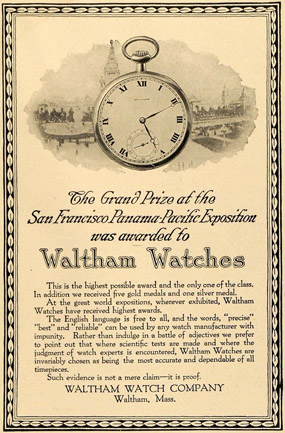 Boston Watch Company
Boston Watch Company
In 1849 Aaron Lufkin Dennison, Edward Howard and David Davis formed a company with a plan to use machinery to manufacture watch movement parts so precisely that they would become fully interchangeable. They initially outfitted space for design and manufacturing in Howard's clock factory in Roxbury, Massachusetts, a community neighboring Boston. In 1851 they moved to a new factory across the street from Howard's clock factory. Based upon the experience of earlier failed trials, Howard and Dennison eventually perfected and patented their precision watch making machines and create the American System of Watch Manufacturing.
In the spring of 1853 the first Dennison, Howard, & Davis watches were offered for sale to the public. The name was changed from Warren Mfg. Co. to Boston Watch Company in September 1853, and a new factory in Waltham, Massachusetts was opened in October 1854. The company produced gilded full plate pocket watches ranging from 7 to 15 jewels which found acceptance in the industry, the first pocket watch produced in America of standard interchangeable parts, fostering growth until the country began experiencing a recession in 1856. Sales dropped, debts climbed and bankruptcy became inevitable. The Boston Watch Company was sold at auction in April 1857.
American Waltham Watch Company Emerges
Royal E. Robbins and D. F. Appleton, New York watch wholesalers, along with Tracy and Baker, watch case manufactures in Philadelphia, purchased The Boston Watch Company factory and part of the other assets at the auction. As majority owner, Robbins reorganized the company as Appleton, Tracy & Co. (Most of the remaining Boston Watch Company material and watches in progress, 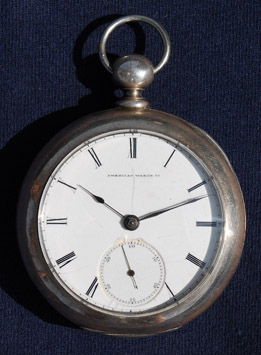 along with some of the watch making machinery were acquired by E. Howard & Co. due to a lien). Aaron Dennison remained in Waltham as the superintendent of the mechanical department.
along with some of the watch making machinery were acquired by E. Howard & Co. due to a lien). Aaron Dennison remained in Waltham as the superintendent of the mechanical department.
The Model 1857 Appleton, Tracy & Co. grade was the first pocket watch produced, it was essentially the same movement as was produced by the Boston Watch Company. It was an 18-size, 15-jewel watch which wound with a key on the back side of the watch, and set with a key from the front. By the end of 1857 the company was producing movements at the rate of 365 per month.
In 1859 the Waltham Improvement Co. and the Appleton, Tracy & Co. merged to form the American Watch Company. Under Robbins leadership the company gradually added less expensive 11-jewel and 7-jewel grade watches to their line. The Civil War provided impetus for growth in watch sales, especially for the American Watch Co. The William Ellery grade (named after William Ellery, one of the signers of the Declaration of Independence) became the popular Civil War soldier's watch. Available as 11-jewel and 7-jewel versions this grade reportedly accounted for 44.6 percent of watches sold by 1865.
In 1859 Belding Dart Bingham, N. P. Stratton, C. S. Mosely and Charles Vander Woerd left the American Watch Company to form the Nashua Watch Company, in Nashua, New Hampshire. The Nashua Watch Co. succeeded in desiging a high grade precision timekeeper and the machinery to build it, but failed financially. In 1862 the American Watch Company absorbed the Nashua Watch Company, including Nashua's superior machinery, creating a separate department to produce high-grade watches. A new wing was added to the Waltham factory to house the Nashau Department where high grade watches were produced independently from the rest of the factory.
In 1866 the Pennsylvania Railroad ordered a number of Model 1857 Appleton, Tracy & Co. grade 15-jewels watches from the American Watch Company, the first American watches specifically made for railroad use.
 Model 1870 Crescent Street designed and marketed for railroad service
Model 1870 Crescent Street designed and marketed for railroad service
The Model 1870 Crescent Street was the first American watch designed and marketed especially as a railroad watch. It was an 18-size, 15-jewel movement, with a chronometer balance, adjusted to "heat and cold" and was among the earliest to include a micrometer regulator, modelled by Charles Vander Woerd. A product of Waltham's Nashua Department, the 1870 Model was introduced as a key-wind key-set watch, with winding and setting from the back. A stem-wind version was introduced in 1871. The Model 1870 Crescent Street was manufactured from 1870 through September 1883, with a total production of 17,900 movements.
The 18-size Model 1877 and Model 1879 Appleton Tracy & Co. and Waltham Watch Co. grades, both stem wind and lever set, with a 15-jewel movement, a chronometer balance and adjusted to positions, replaced the 1857 Model grades and were manufactured to meet railroad time service requirements at the time.
Model 1883 Crescent Street introduced
The 18-size Model 1883 Crescent Street grade replaced the Model 1870 Crescent Street as Waltham's highest-grade full-plate watch with its introduction in 1885. The Model 1883 Crescent Street grade was stem wind and lever set, with a 15-jewel movement, a chronometer balance and adjusted to temperature and positions, a 17-jewel version was subsequently introduced.
Additional Model 1883 grades manufactured to meet railroad requirements at the time, included:
- Appleton, Tracy & Co. (15-jewel and 17-jewel), adjusted to temperature and positions;
- Riverside (15-jewel and 17-jewel), adjusted to temperature and positions;
- Waltham Watch Co. (15-jewel only), adjusted to temperature and positions;
- No. 45 (17-jewel), adjusted to temperature and positions;
- No. 35 (15-jewel and 17-jewel), adjusted to temperature and positions;
- No. 25 (15-jewel and 17-jewel), adjusted to temperature and positions;
- No. 87 (17-jewel), adjusted to temperature,
- No. 85 (17-jewel), adjusted to temperature.
In 1885, after 26 years, the company name changed to American Waltham Watch Co. where it was to remain for the next 22 years.
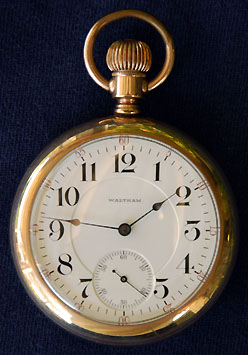 Vanguard Movement Introduced
Vanguard Movement Introduced
The American Waltham Watch Co. introduced the 18-size, 17-jewels Vanguard movement in 1894, advertising the new model as "the finest 18-size movement in the world". As other grades were added, the model be came known as the Model 1892. The Model 1892 Vanguard remained Waltham's highest-grade 18-size watch, versions with 19, 21 and 23 jewels were subsequently introduced, all adjusted to temperature and 5 positions.
Other Model 1892 railroad standard grades included:
- Crescent Street, 19-jewel and 21-jewel, adjusted to temperature and 5 positions;
- No. 845, 21-jewel, adjusted to temperature and 5 positions;
- Appleton, Tracy & Co. 17-jewel, adjusted to temperature and 3 positions, replaced by the 17-jewel Appleton Tracy & Co. Premier in 1902, adjusted to temperature and 5 positions;
- Riverside, 17-jewel, adjusted to temperature and 3 positions;
- Railroader, 17-jewel, adjusted to temperature and 3 positions.
The The Model 1892 was manufactured through 1918. The Model 1892 was considered one of Waltham’s most successful watches.
Royal E. Robbins continued to manage the company until his death in 1902. In 1907 the name changed to Waltham Watch Co., in 1923 briefly to Waltham Watch and Clock Company and finally in 1925 to Waltham Watch Company.
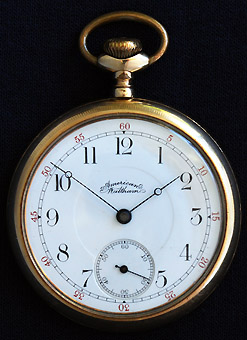 Smaller 16-size Watches Introduced
Smaller 16-size Watches Introduced
The American Watch Company is credited with introducing the American 16-size watch with the KW-16 model in 1862. A product of Waltham's Nashua Department, the KW-16 was a 3/4 plate, key wind movement which was available in the American Watch Co. grade, the Appleton Tracy & Co. grade and the A. W. Co. grade, all with a chronometer balance and adjusted to "heat and cold". The smaller size was slow to be adopted, 20 years later it only accounted for 5% of watch production.
A new 1868 model replaced the original KW-16 model with the Appleton Tracy & Co. grade, the Amn. W. Co. grade and the A. W. Co. grade all with a chronometer balance and adjusted to "heat and cold". The Model 1868 was available as keywind and stemwind.
The American Watch Co. Model 1872 replaced the Model 1868, also produced by the Nashua Department. The 3/4 plate movement featured a new design with the winding wheels were located above the top plate. The movement was available as hunting and open face, stemwind and lever set. The highest grade was the American Watch Co. grade, 21-jewel, with a patent regulator, compensation balance, patent Breguet hairspring, adjusted to temperature, isochochtonism and positions. The Amn. W. Co. grade (15-17 jewel) and the Riverside grade (15-jewel) were also adjusted to temperature, isochronism and positions. The Park Road grade was adjusted to temperature and isochronism.
The American Waltham Watch Co. continued to develop the 16-size lines with the innovative Model 1888, also available as hunting and open face. Several Model 1888 grades included a patent regulator, compensation balance, patent Breguet hairspring, adjusted to temperature and positions, and were manufactured to meet railroad requirements at the time including:
- American Watch Co., 21-jewel, adjusted to temperature and 5 positions
- Riverside Maximus, 21-jewel, adjusted to temperature and 5 positions
- Riverside, 15-jewel and 17-jewel, adjusted to temperature and positions;
- Railroader, 17-jewel adjusted to temperature and positions;
- No. 650, 17-jewel, adjusted to temperature and positions;
- Am. Watch Co. 16-jewel and 17-jewel, adjusted to temperature and positions;
- Royal, 17-jewel (17-jewel adjusted version only), adjusted to temperature1.
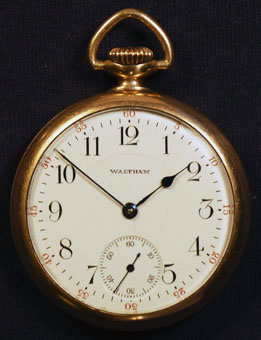 Popularity of 16-size movements increased after the establishment of railroad standards in 1892, reaching 15% of production by the turn of the century.
Popularity of 16-size movements increased after the establishment of railroad standards in 1892, reaching 15% of production by the turn of the century.
Model 1899 Introduced, 16-size Popularity Grows
Production of the 16-size watches grew during the first decade of the new century with American Waltham's very successful Model 1899 and Model 1908 movements, Model 1899 and Model 1908 railroad grade movements included:
- Riverside Maximus, 21-jewel and 23-jewel, adjusted to temperature and 5 positions;
- Vanguard, 19-jewel to 23-jewel, adjusted to temperature and 5 positions;
- Crescent Street, 19-jewel and 21-jewel, adjusted to temperature and 5 positions;
- No. 645, 21-jewel, adjusted to temperature and 5 positions, 1906-1918;
- Riverside 17-jewel and 19-jewel, initially adjusted to temperature and 3 positions, later to 5 positions, mfg. through 19263;
- No. 642, 17-jewel, adjusted to temperature and 5 positions, mfg. 1918;
- No. 636, 17-jewel, adjusted to temperature and 4 positions, mfg. 1910, 19132;
- Royal, 17-jewel, adjusted to temperature and 3 positions, mfg. through 19222;
- No 640, 17-jewel, adjusted to temperature and 3 positions, mfg. 1923-19262;
- No 637, 17-jewel, adjusted to temperature and 3 positions, mfg. 1910-19192.
Total 16-size watch movement production exceeded 18-size watches by 1915. The last 18-size Model 1892 Vanguard and Crescent Street grades were manufactured in 1914, yielding to the growing dominance of 16-size railroad quality watch sales.
Production of the Model 1908 No. 645 grade continued through 1918. Production of the Model 1908 Riverside grade continued through 19263. Production of the Model 1908 Crescent St. grade ended in 1929. Production of the Vanguard grade continued as the Model 1623 Vanguard through 1953.
The Waltham Watch Company founded a subsidiary in Switzerland in 1954. Waltham continued to manufacture watches (and clocks) until 1957, when they ceased production and became the Waltham Precision Instrument Company. The rights to the name "Waltham Watch Company" were sold to the Hallmark Watch Company of Chicago, Illinois who sold imported watches using the Waltham name.
Waltham railroad grade watches (not all were railroad approved)
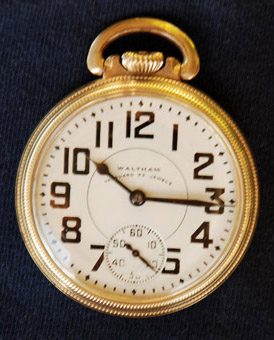 The following is from list of railroad grade watches which is general attributed Webb C. Ball. Not all of these were railroad approved even though all are railroad grade.
The following is from list of railroad grade watches which is general attributed Webb C. Ball. Not all of these were railroad approved even though all are railroad grade.
- 18 Size: 1857 KW with Pennsylvania R.R. on dial, Appleton Tracy & Co. on movement.
- Crescent Street, 17-23J, 1870, 1883 & 1892 Models
- Appleton Tracy & Co., 1892 Model
- Railroader, 1892 Model
- Pennsylvania Railroad
- Special Railroad, Special RR King, Vanguard, 17-23J, 1892 Model
- Grade 845, 21J, 1892 Model
- 16 Size: American Watch Co., 17-21J, 1872 Models
- American Watch Co., 17-23J, Bridge Models,
- Crescent Street, 17-21J, 1899 & 1908 Models
- Premier Maximus, 23 J
- Railroader, 17J 1888 Model
- Riverside Maximus, 21-23J
- Vanguard, 19-23J
- 645, 19-21J
- All wind indicators
Waltham Production Dates by Serial Number
Note: These are approximate dates, actual dates may vary by years. The serial number being referred to is the serial number on the movement of the watch, not the case.
| 1852 - 50 | 1874 - 730,000 | 1896 - 7,450,000 | 1918 - 21,800,000 | 1940 - 30,250,000 |
| 1853 - 400 | 1875 - 810,000 | 1897 - 8,100,000 | 1919 - 22,500,000 | 1941 - 30,750,000 |
| 1854 - 1,000 | 1876 - 910,000 | 1898 - 8,400,000 | 1920 - 23,400,000 | 1942 - 31,050,000 |
| 1855 - 2,500 | 1877 - 1,000,000 | 1899 - 9,000,000 | 1921 - 23,900,000 | 1943 - 31,700,000 |
| 1856 - 4,000 | 1878 - 1,150,000 | 1900 - 9,500,000 | 1922 - 24,100,000 | 1944 - 32,100,000 |
| 1857 - 6,000 | 1879 - 1,350,000 | 1901 - 10,200,000 | 1923 - 24,300,000 | 1945 - 32,100,000 |
| 1858 - 10,000 | 1880 - 1,500,000 | 1902 - 11,100,000 | 1924 - 24,550,000 | 1946 - 32,350,000 |
| 1859 - 15,000 | 1881 - 1,670,000 | 1903 - 12,100,000 | 1925 - 24,800,000 | 1947 - 32,750,000 |
| 1860 - 20,000 | 1882 - 1,835,000 | 1904 - 13,500,000 | 1926 - 25,200,000 | 1948 - 33,100,000 |
| 1861 - 30,000 | 1883 - 2,000,000 | 1905 - 14,300,000 | 1927 - 26,100,000 | 1949 - 33,500,000 |
| 1862 - 45,000 | 1884 - 2,350,000 | 1906 - 14,700,000 | 1928 - 26,400,000 | 1950 - 33,560,000 |
| 1863 - 65,000 | 1885 - 2,650,000 | 1907 - 15,500,000 | 1929 - 26,900,000 | 1951 - 33,600,000 |
| 1864 - 110,000 | 1886 - 3,000,000 | 1908 - 16,400,000 | 1930 - 27,100,000 | 1952 - 33,700,000 |
| 1865 - 180,000 | 1887 - 3,400,000 | 1909 - 17,600,000 | 1931 - 27,300,000 | 1953 - 33,800,000 |
| 1866 - 260,000 | 1888 - 3,800,000 | 1910 - 17,900,000 | 1932 - 27,550,000 | 1954 - 34,100,000 |
| 1867 - 330,000 | 1889 - 4,200,000 | 1911 - 18,100,000 | 1933 - 27,750,000 | 1955 - 34,450,000 |
| 1868 - 410,000 | 1890 - 4,700,000 | 1912 - 18,200,000 | 1934 - 28,100,000 | 1956 - 34,700,000 |
| 1869 - 460,000 | 1891 - 5,200,000 | 1913 - 18,900,000 | 1935 - 28,600,000 | 1957 - 35,000,000 |
| 1870 - 500,000 | 1892 - 5,800,000 | 1914 - 19,500,000 | 1936 - 29,100,000 | |
| 1871 - 540,000 | 1893 - 6,300,000 | 1915 - 20,000,000 | 1937 - 29,400,000 | |
| 1872 - 590,000 | 1894 - 6,700,000 | 1916 - 20,500,000 | 1938 - 29,750,000 | |
| 1873 - 680,000 | 1895 - 7,100,000 | 1917 - 20,900,000 | 1939 - 30,050,000 |
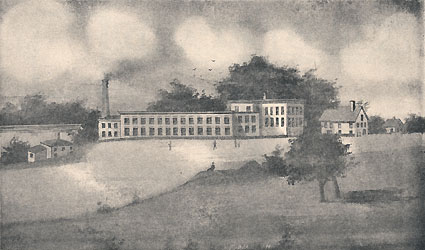 |
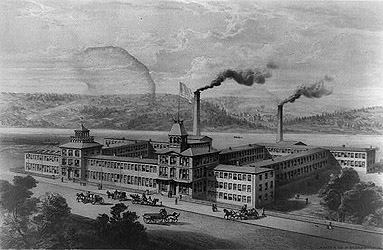 |
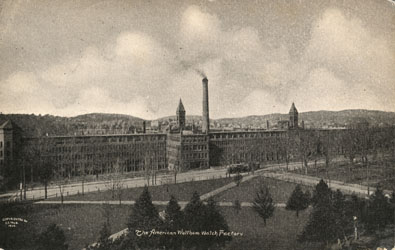 |
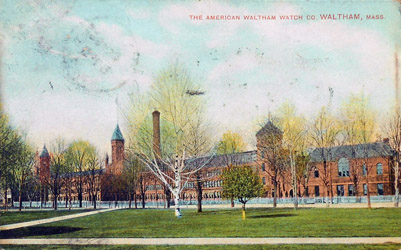 |
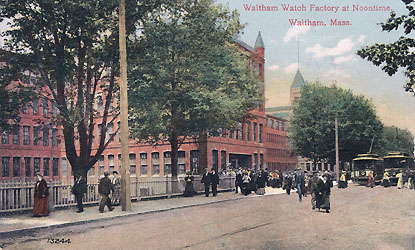 |
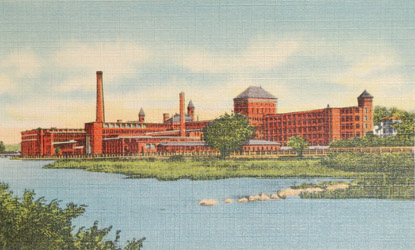 |
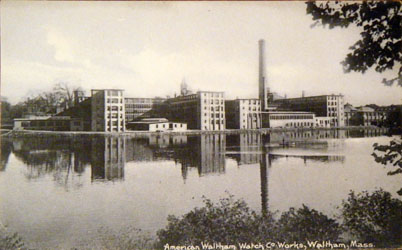 |
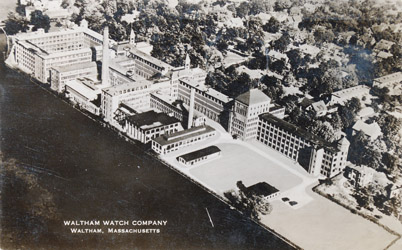 |
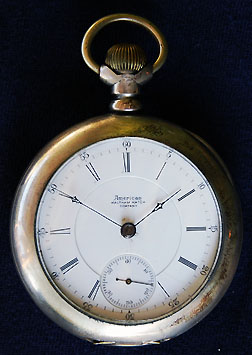 Links to other sites for additional information:
Links to other sites for additional information:
American Watch Company Web - an organization of watch and clock collectors with an interest in sharing information with other collectors over the Internet.
Waltham Model 1892 Research Website - American Waltham Watch Co. introduced the Vanguard movement in 1894. As the Crescent Street and other grades were added, the model be came known as the Model 1892. It was one of Waltham’s most successful watch models.
Pocket Watch Database: - Serial number lookup and information for Hamilton, South Bend, Illinois, Rockford, Waltham & Elgin.
References, for additional reading:
Abbott, Henry G., History of the American Waltham Watch Company of Waltham, Mass, American Jeweler Print, 1905.
De Fazio, Thomas L. The Nashua Venture and the American Watch Company. Bulletin of the National Association of Watch and Clock Collectors, Inc., December 1975, pgs 575-589, Columbia, PA.
Erhardt, Roy, Waltham Pocket Watch Identification and Price Guide, Heart of America Press, Kansas City, MO, 1976.
Erhardt, Roy and William "Bill" Meggers Jr., American Pocket Watches: Identification and Price Guide Beginning to End, Heart of America Press, Kansas City, MO, 1987.
Harold, Michael C. American Watchmaking: A Technical History of the American Watch Industry 1850-1930. A supplement to the Bulletin of the National Association of Watch and Clock Collectors, Inc., Number 14, Spring 1984, Columbia, PA.
Tom McIntyre and Whit Joyner, The Waltham 1870 Model. Bulletin of the National Association of Watch and Clock Collectors, Inc., July/August 2012, pgs 339-351, Columbia, PA.
The Perfected American Watch, American Waltham Watch Company, Waltham Mass., 1900.
The Story of the Waltham Watch, with Retail Selling Prices, Waltham Watch Coompany, Waltham Mass., 1923.
1 By the early-1890's new watches entering railroad service were required to be adjusted to isochronism, temperature and position on a growing number of railroads that required watch inspection. In creating watch standards for the Lake Shore & Michigan Southern Railway Co. Webb C. Ball, Chief Inspector of Watches, on August 15, 1891 indicated the standard adopted by the Company for its employes' watches now in service is one is equal to what is generally known among American movements as the "15-jewels, Patent Regulator, adjusted." Ball indicated this quality of movement "is represented by the Elgin Raymond and No. 70, by the Waltham No. 35 and Crescent Street, by Hampden Perry and Railway, Nos 59 and 60, by the Howard 'Gilt Heat and Cold,' and all grades above those named." Other railroads, including the Illinois Central Railroad Co. in 1892 continued to accept "American movements as fifteen-jewel, patent regulator, adjusted to heat and cold, the variation of which must not exceed 30 seconds per week." By the mid-1890's 18-size, 17-jewel pocket watches adjusted to positions dominated sales for railroad service.
2 Most major railroads and some interurban electric railways had raised the minimum requirement to 5 positions for new watches entering service 1906-1908. After that time 17-jewel watches adjusted to 3 and 4 positions were often advertised for electric railway service, they were only accepted for service on a limited number of railroads., Similarly, pendant-set watches were commonly accepted for railroad service until 1906-1908.
3 The Riverside name was subsiquently applied to Waltham's 16-size 21-jewels grade No. 1621 which lacked a patent micrometric regulator and was only adjusted to temperature, it did not meet the published requirements of the major railroads.
American Waltham Aurora Ball Columbus Elgin National Hamilton Hampden E.Howard Illinois Peoria Rockford South Bend Seth Thomas U.S.Marion U.S.Waltham
Sharing A Heritage Railroad History Train Technology Railroad Operation Railroad Time Museums & Heritage Railroads Railroads Today
